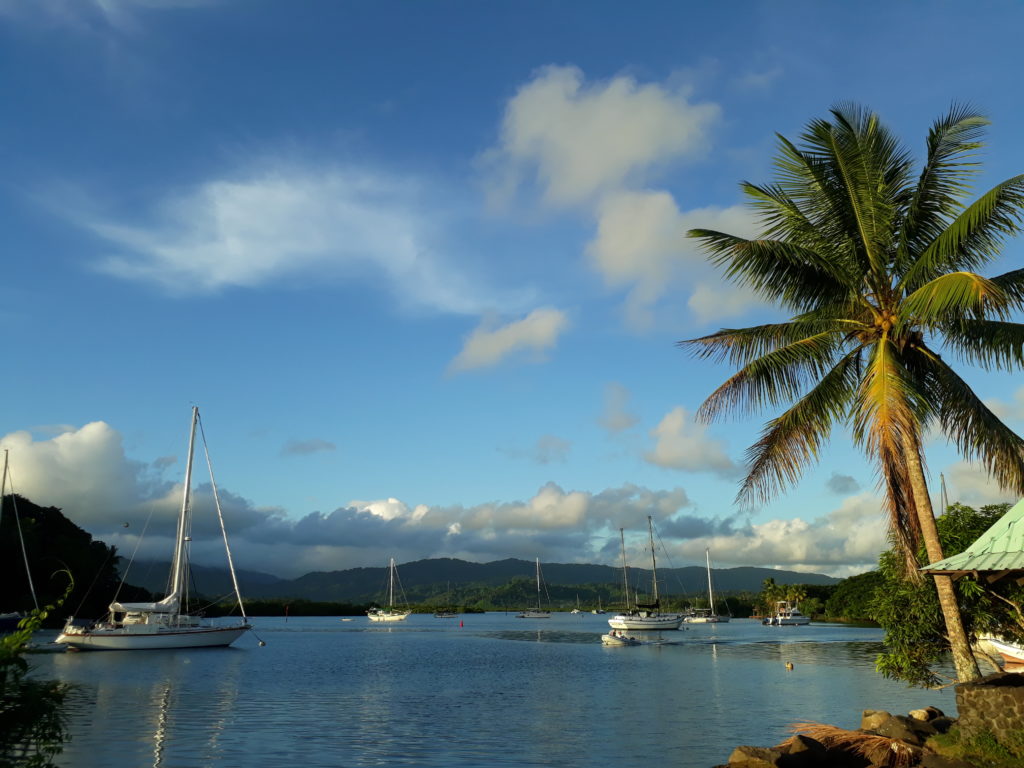
After crossing from New Zealand to Fiji onboard North Star with Steve and Kim, I did my shortest move ever and jumped ship to Macushla, docked about 3 boats away. I had met Mark at the Copra Shed Marina in Fiji during a cruiser dinner. The cruising community seems to love to catch up with each other every chance they get over food and wine. He had just done the same passage single-handed and even though at first he wasn’t too sure about taking crew, we decided to give it a go. Being two would allow us to explore more remote areas and avoid all the reefs when entering bays.
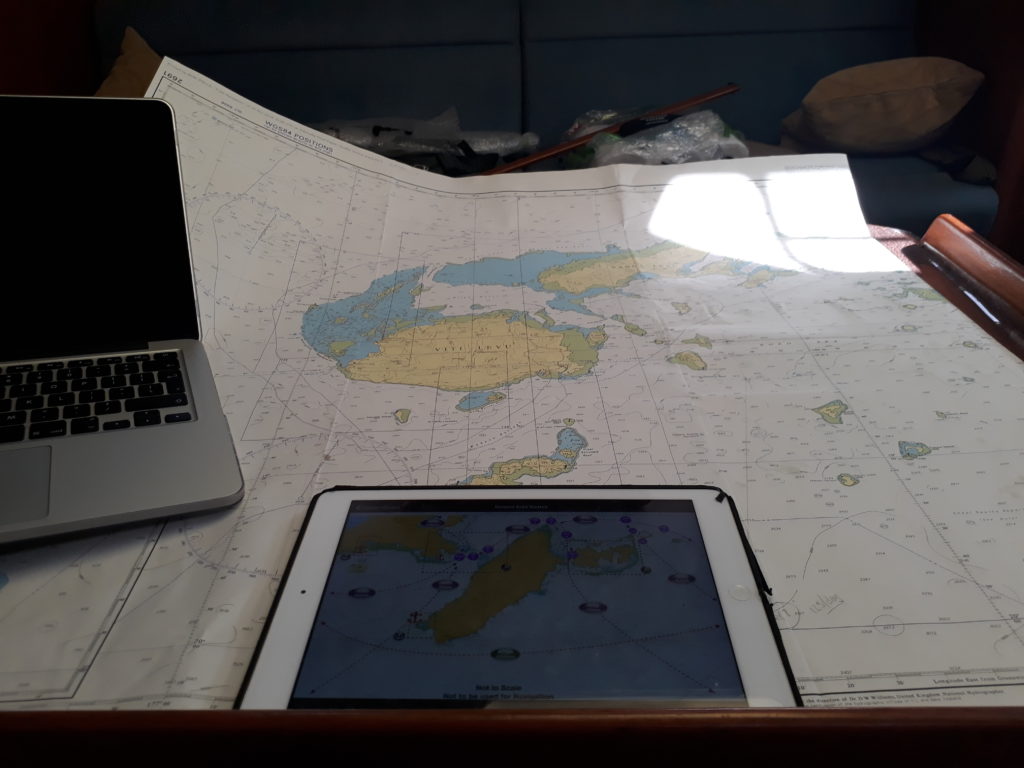
When we discussed the possibility of me joining him, it quickly became clear I had somehow managed to find the only other vegan sailboat in the area. Sharing the same diet does make it a lot easier for meal planning when sailing.
Once we decided to explore the islands together, we bought some food supplies and filled the water and the fuel tanks. I learned how to row on the dinghy. Of course, for my first time, I zigzagged a lot on the way to the fuel dock. And did a big unplanned detour on the way back. The second trip was much better, I finally managed to go in an almost straight line.
We were ready to leave the marina. I asked Mark if he wanted me to do the lines and he answered that I could stay at the helm. It got me quite nervous. I now had to reverse a boat I had never steered before and of course, avoid buoys and other sailboats. There was plenty of room, and he kept a close eye to make sure I didn’t do any mistakes (that is his home after all!) and of course I was nervous for no reason and it all went well.
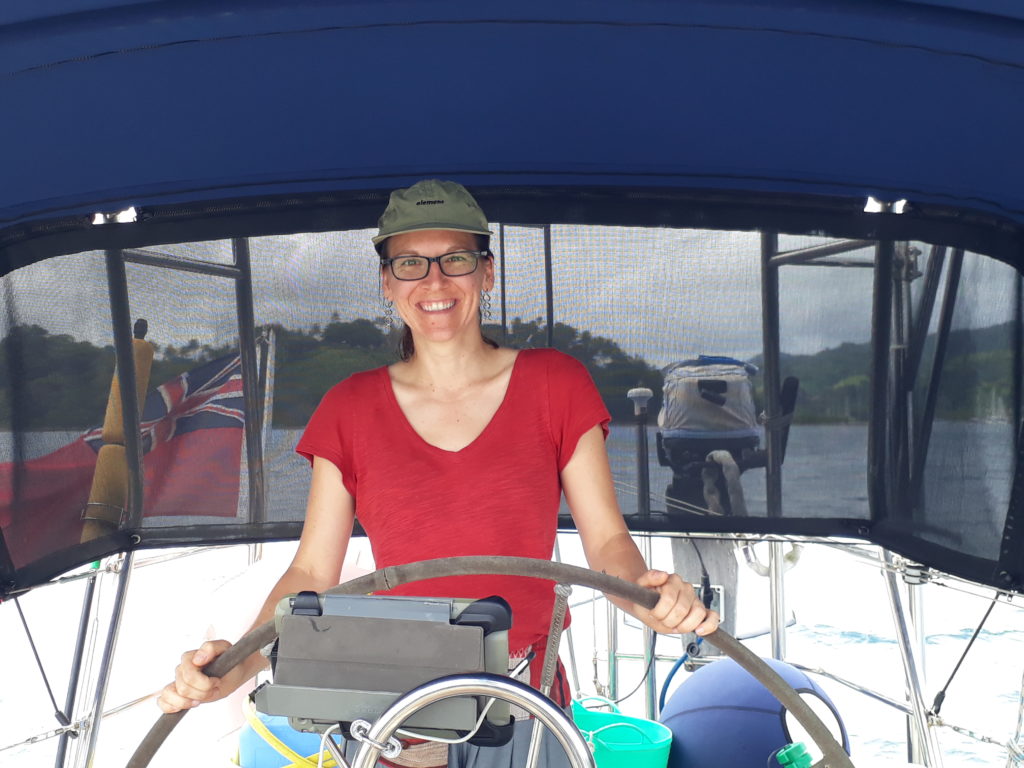
It allowed me to get a really good feel for the boat and I motored the entire way to our first anchorage, in front of the Cousteau Resort. Usually, sailors do not get to do that until much later on in the training. It set the tone for our trip, which was a very hands-on learning experience, including everything from planning and plotting courses, finding suitable anchorages, steering, etc.
The Jean-Michel Cousteau Resort is a high-end 5-star luxury eco-resort, where people go for their honeymoon, get spa treatments and can do their PADI courses to become divers. To say that this is not quite my usual environment would be an understatement. We stopped only because it was a short sail trip from the marina, and it allowed us to double-check that everything was working properly before we headed towards the unknown and less developed islands.
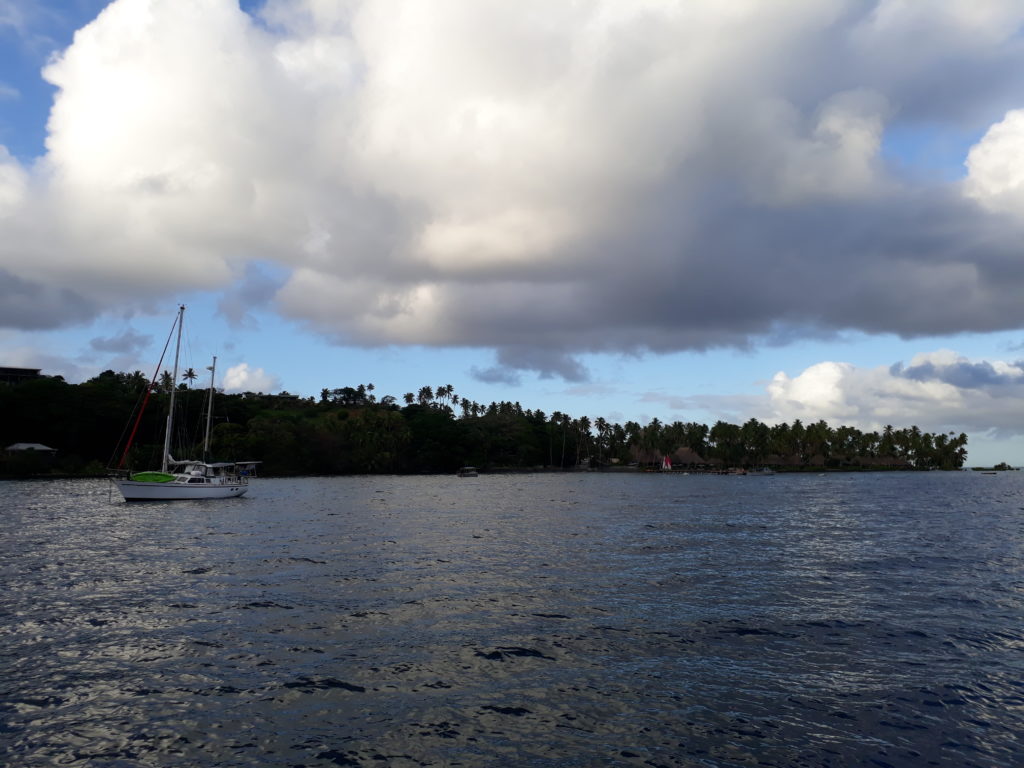
I’ve always been a very nervous swimmer, rarely going in if the water is cold, if it’s deep or if it’s not super clear water… I’d been wanting to conquer that fear of water for a very long time, knowing how ironic it was to be a sailor, passionate about marine life, yet afraid to get in!
This first day not in the marina seemed to be the perfect opportunity to start working on my fear. The water was calm, crystal clear, and warm. I was very nervous and hugging the ladder for most of the five first minutes but slowly I eased into it, swimming very close to the boat to start with. Keeping my hand on the ladder. Mark came from under the boat where he was scraping the bottom and it startled me a lot, but then having someone to talk to meant that I was distracted enough to not be as scared anymore.
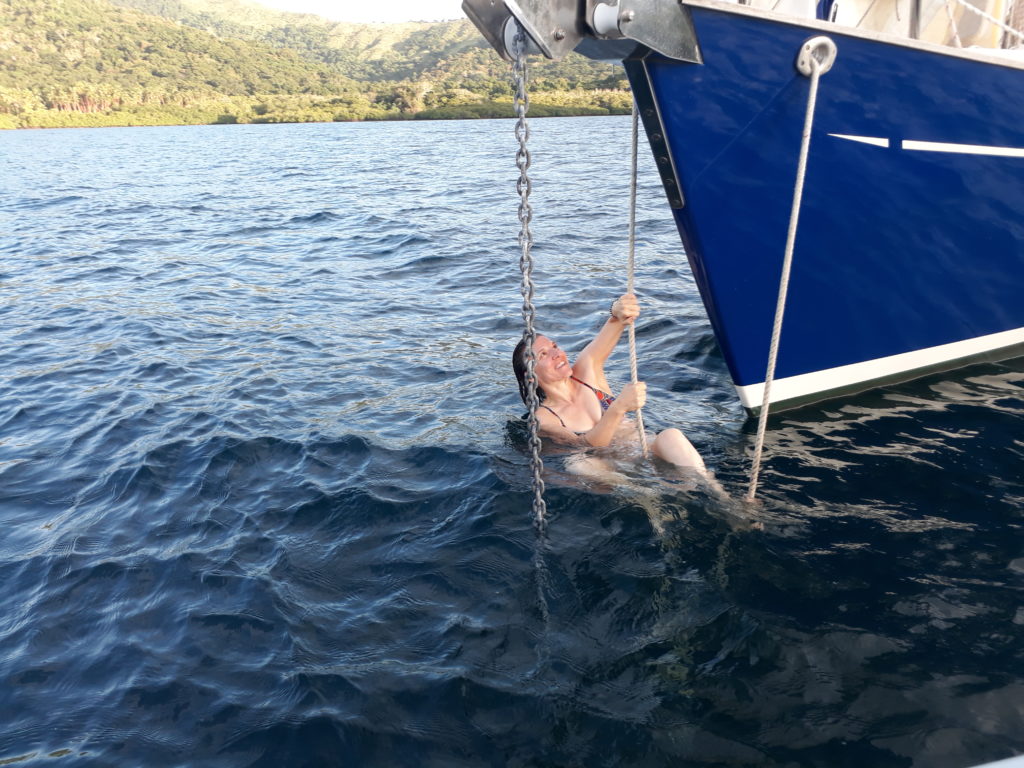
I climbed onto the anchor chain and played with the anchor line. I kept swimming back and forth between the ladder and the anchor, trying not to think about the fact that we were anchored in 18m deep!
The next day, we left Cousteau anchorage and sailed on the other side of the reef. Unfortunately, the wind wasn’t helping us much so we had to tack and then motor sail for a while. I steered for most of the way and eventually used the autopilot too. It did rain a fair amount as we were leaving and without North Star’s enclosure, I was drenched within minutes. Thankfully it wasn’t too cold, so it ended up being fun anyway.
Fawn Bay
We came through Fawn Bay, Mark on the helm and myself watching out for corals in front of the boat. We zigzagged to the anchorage and I went for yet another swim. This time I didn’t take as long to get in, I even swam around the boat, enjoying the sun setting over the islands, the mangroves and the beautiful pastel colours on the reef with Taveuni Island in the background.
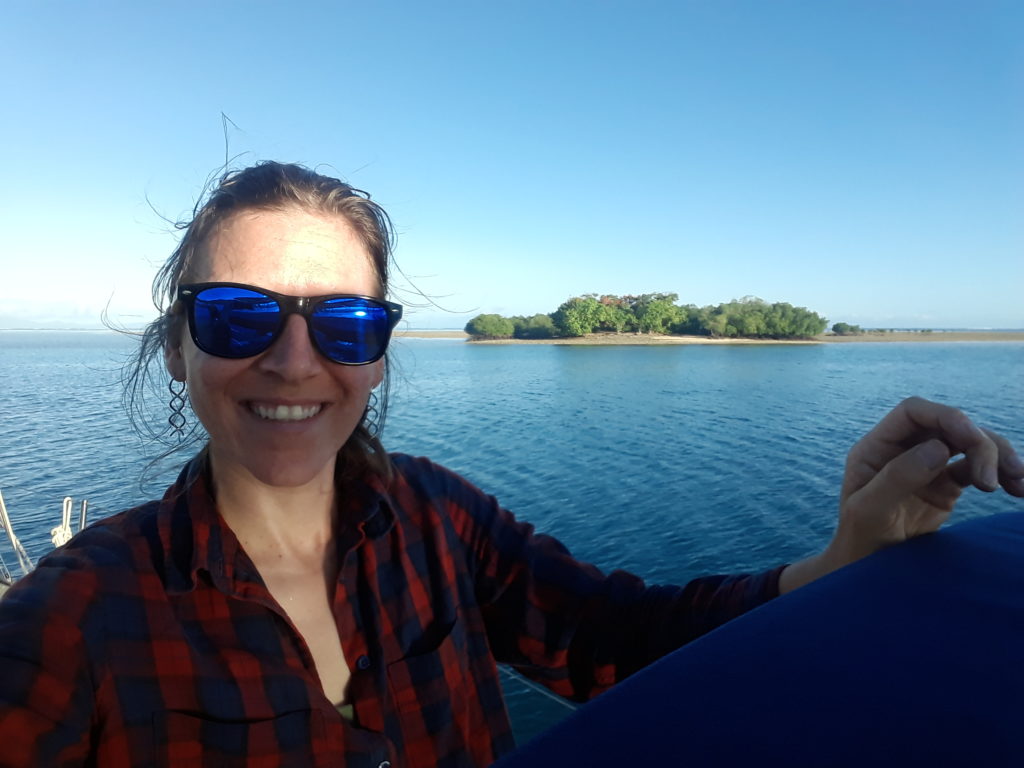
It was a perfect idyllic location, a secluded bay with a couple of huts and houses in the distance. Most small bays in Fiji had that honeymoon feeling. It would have been great with a partner. Made it a bit awkward at times with someone I didn’t know.
As we were having breakfast the next day, Arthur Pickering came to see us in his small boat and told us about his family’s history. Since Fiji was a British Colony until 1970, a handful of Fijian families originated from mixed marriages between Europeans and Fijians, resulting in a different gene pool.
Arthur was a good example as he had light coloured eyes and European features with a darker skin tone.
We watched the local villagers have a picnic on the mangrove island and then I steered on the way out back to the open seas. It was a bit stressful because the reefs felt pretty damn close but it turns out it wasn’t all that bad. We tried putting the sails up but there wasn’t enough wind.
Nasau Bay
We motored until the Nasau Bay anchorage. We arrived fairly early so we felt obliged to go ashore and to do the sevusevu. The sevusevu is a traditional Fijian protocol when visitors arrive in a village. It is also called Kava or Yaqona. It’s a dried root, pounded into a powder and then turned into a mildly intoxicating drink. Sevusevu is important and still part of Fijian life. There’s an entire protocol to follow, including the numbers of times to clap in your hands at different moments. The chief has his own bowl to drink from, whereas everyone else from the village and the guests share another one. We had read about it, memorized the sentence we had to say, but yet we didn’t know what to expect.
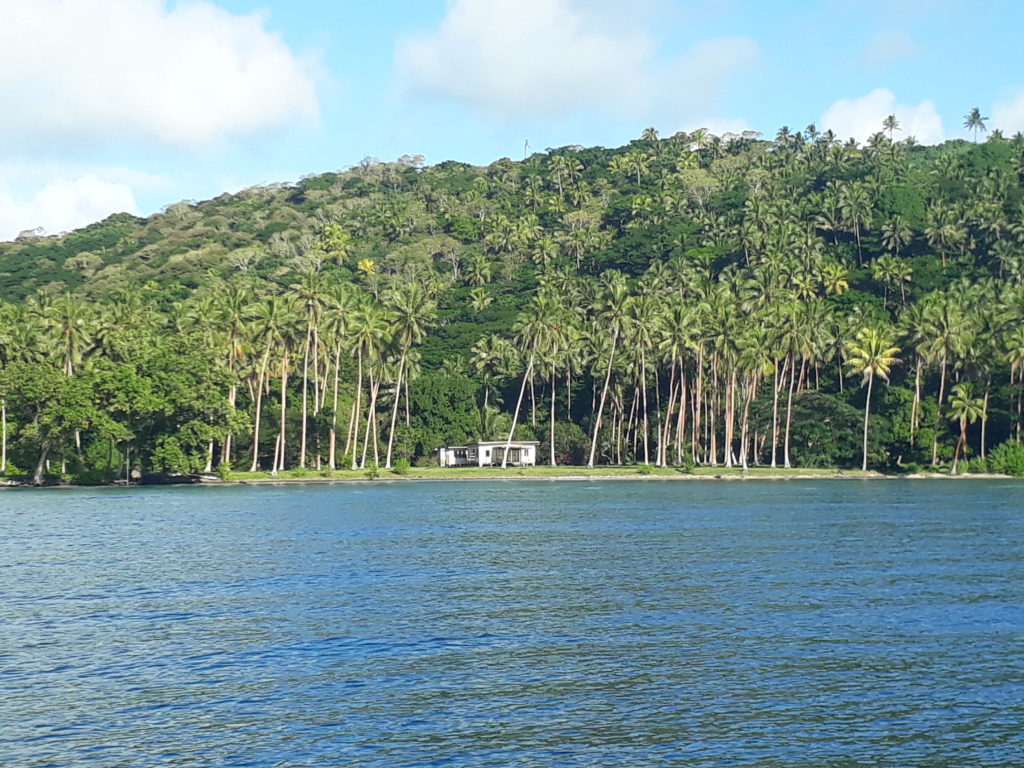
We paddled to the house where we were greeted by Maria and her special needs son. Her husband was away so we handed her the Yangon and had a bit of a chat. We then proceeded to explore the beach and the surroundings. It felt good to finally stretch my legs and walk for more than 7m!
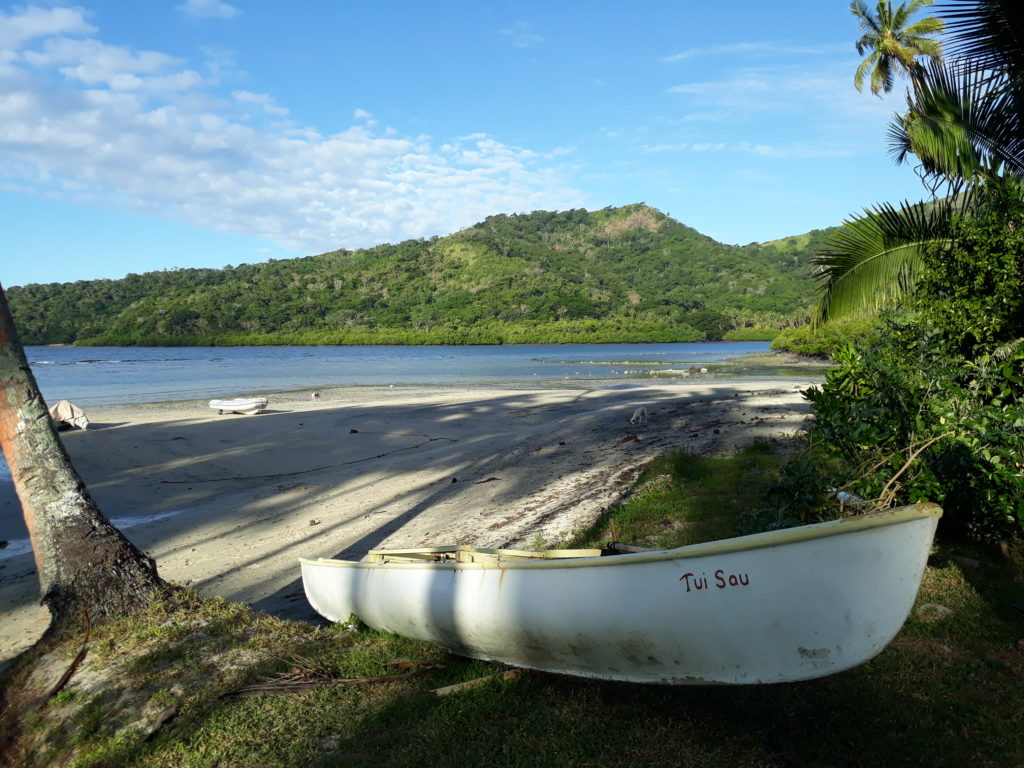
By then I felt like I was learning a lot which was great, but also that I didn’t have any time to myself. Or at least rarely for more than five minutes and it was starting to get to me. I am rather independent and I value my alone time a lot. I’ve realized over time that I need that quiet time to process my experience and simply turn back towards myself. It allows me to be aware of my feelings, reconnect, and recharge my inner batteries. Therefore, it is essential to my well-being.
Stunning Albert Cove
We had originally planned to stop on Kioa Island before heading out North, but the winds were picking up and the anchorage we had planned to use was not sheltered. It would have been a very rocky and uncomfortable anchorage so we changed our plans and chose to head to Albert Cove directly instead.
Kioa Island is one of the two nations within a nation in Fiji and my first realization that climate change was already affecting people. It’s one thing to hear about the sea levels rising, but it’s another thing to see a nation already partly displaced by it. The population of Kioa originates from Tuvalu, a group of three reef islands and six atolls, located about 1 180km North of Fiji . Tuvalu’s nine islands have an average height of just 3 meters above sea level. This is also the average height between the floor and the ceiling in most houses (9ft, or 2.74m).
We managed to sail for most of the way up along Kioa and Rabi islands. I steered the entire time once again, finding the sweet spot between having the wind right behind us, with sails flapping, and staying on course. Sailing past the islands, all the villages seemed very small around Fiji. Even ”busy” places or towns are not much more than a few buildings and a church.
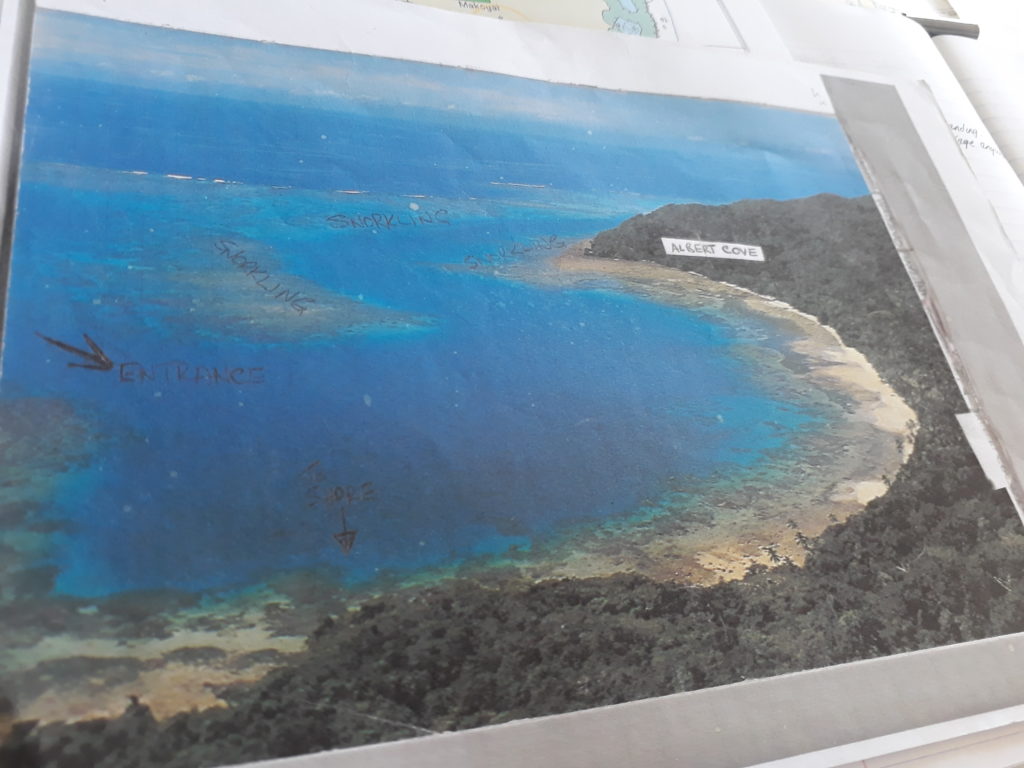
The entrance to Albert Cove was also a bit stressful because it’s quite narrow and one of the GPS was not following us anymore but with Mark on top of the dingy we made it to a safe anchorage. As we were coming in, we had the surprise visit of a pod of about 15 dolphins who were feeding. It was beautiful. And distracting!
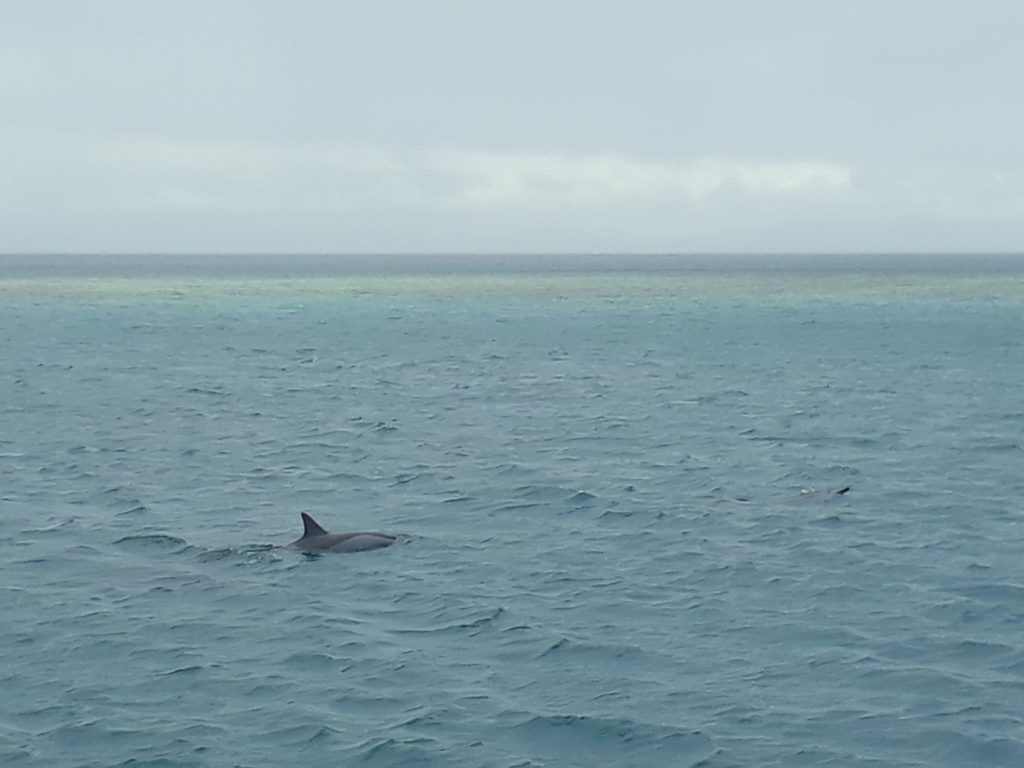
Shortly afterwards, we had the visit of Marie, Joseph and their two little ones (Emmanuel 5, and Marie 3). They came to ask if we could fix their engine on the dingy. Marie said that they were visiting her mom and sister and asked about Kava and fuel. We weren’t ready to go ashore yet and knowing that sevusevu usually lasts for a while, we told them we would bring the Kava when we would go to shore. We had assumed everyone would go to church on Sunday, so we decided to postpone our visit and sevusevu for the next day.
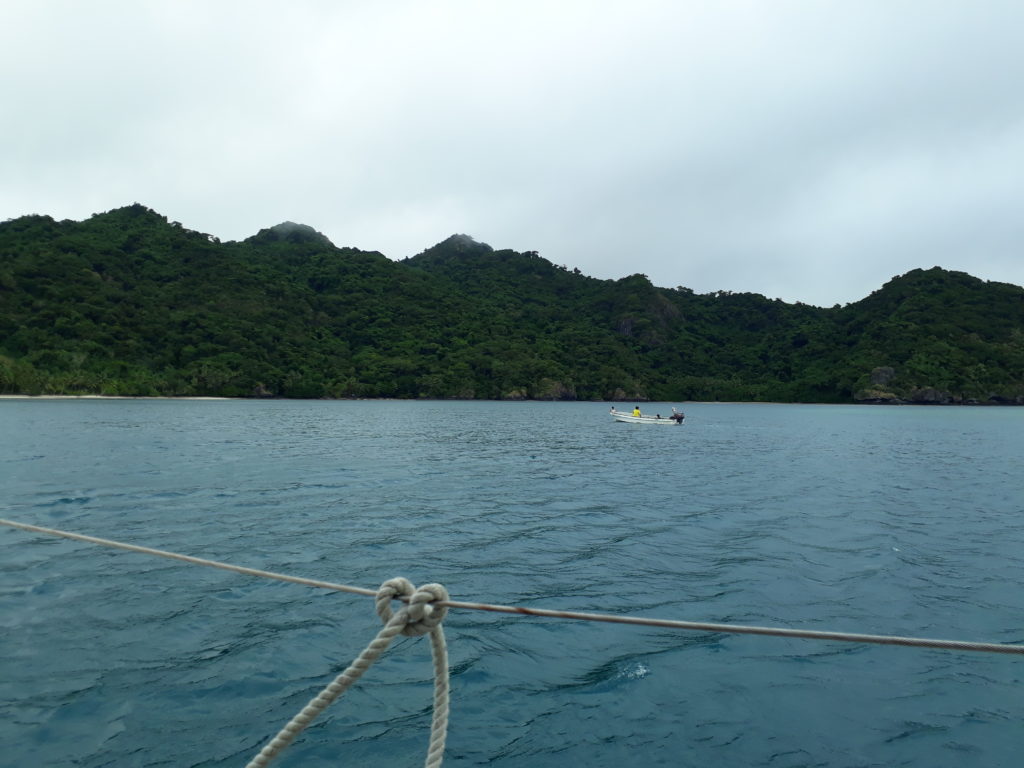
Albert Cove is a rather remote area, and no cellphone signal reaches there. This means we had a few days fully disconnected from the world. Every time I experience being disconnected I realize how much time we spend online. It can be slightly scary sometimes to think that you are completely unreachable. But I’m not going to lie, it also gives a much welcome break!
The sea was pretty calm in Albert Cove even though it was very windy. I wasn’t feeling too confident going snorkelling so we paddled in the dingy to the start of the reef. At that point, my goal was simply to get in the water. I surprisingly managed to stay calm and enjoy the beautiful coral, and the colourful fish. I stayed in for a long time again, until I was shivering and very cold. I was proud of myself. I was making amazing progress to beat my fear of water.
Up the mast!
After our morning snorkel session, I offered to go up the mast to change the wind indicator. Mark harnessed me up, I did a little trial of using the stopper and the feet straps and went up right away. It’s quite challenging to go around the lines and wires holding the mast but since I love climbing I thrived and managed to go up quite quickly.
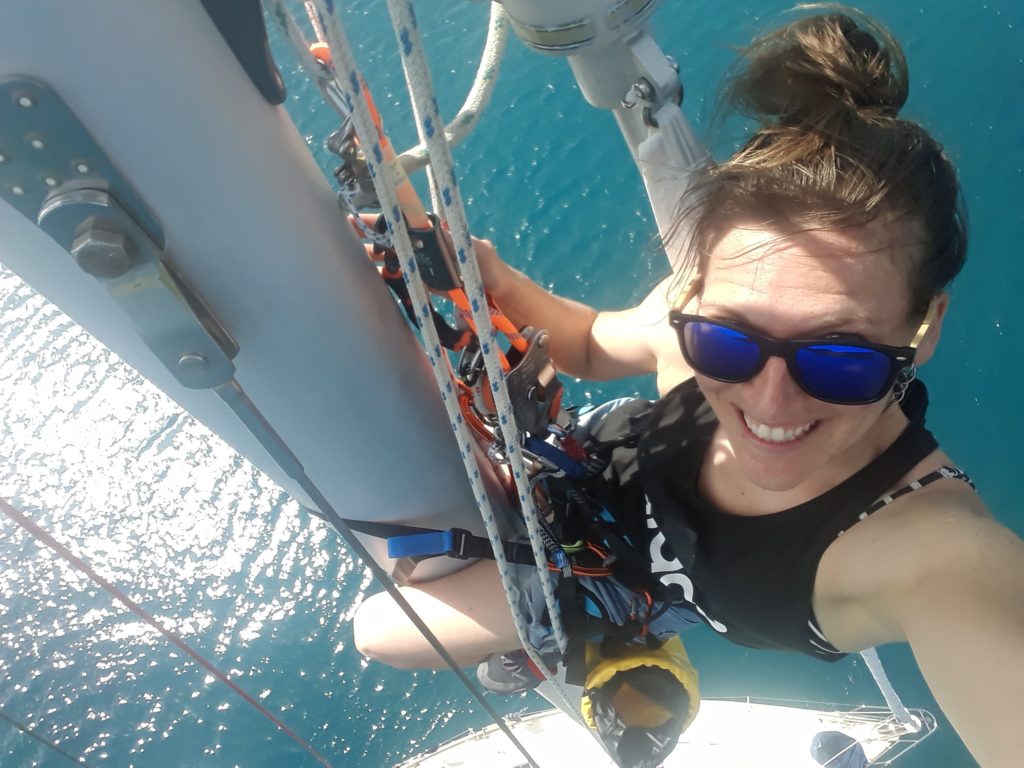
The view from the top was truly amazing with the turquoise water. I even saw a turtle from up there. I easily removed the old wind indicator, Mark sent the new one up and I fixed it.
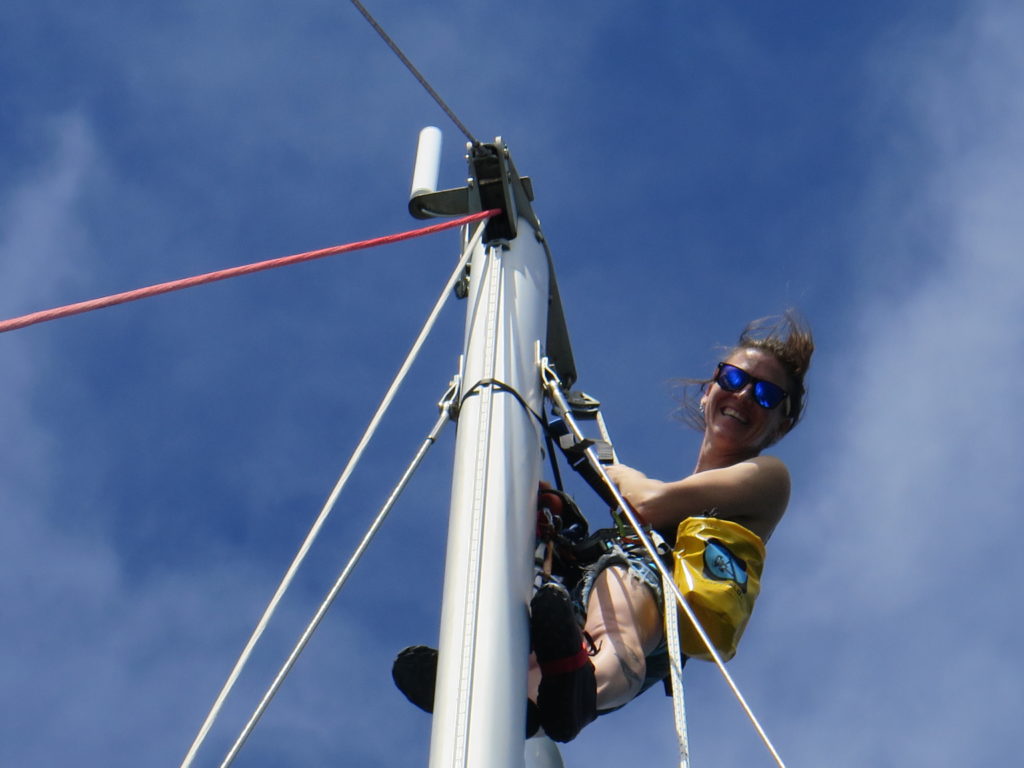
I was just a bit too short to reach comfortably but by using the feet support and lifting myself, I got it installed on my second attempt. It did give me a good rush of adrenaline and I was so pumped I decided to go snorkelling one more time, this time leaving from the boat.
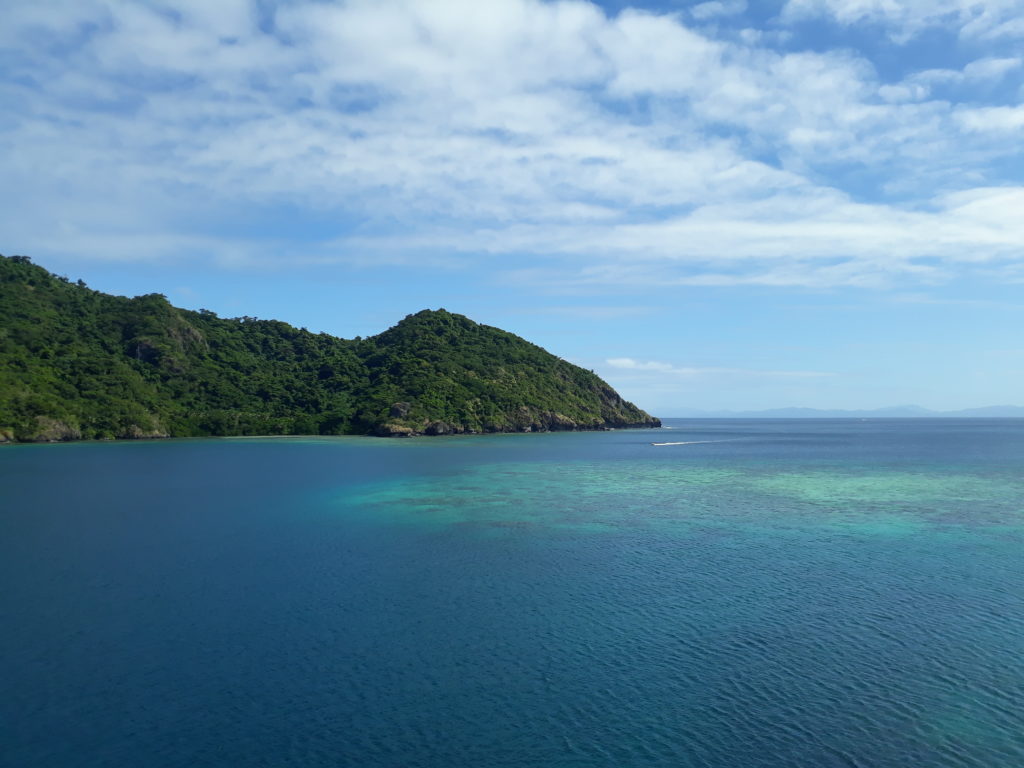
Snorkelling with 20m of water underneath me was quite overwhelming and nerve-racking but as I was getting really nervous, we finally arrived at the reef. Everything became visible and I admired the tons of colourful fish, keeping my breathing pretty calm and steady. I once again stayed in the water until I felt really cold. Then we swam back to the boat. I never thought I would manage to snorkel much without panicking let alone swimming straight from the boat!
Banabans in Fiji
We went ashore in Albert Cove to give our Sevusevu. We paddled to the beach and stopped in the first house we saw. It was more of a temporary house made of palm tree leaves woven into carpet and ceiling, with a fire on one side and a slightly elevated sleeping area (to prevent sleeping in the mud, and to also keep the wild pigs away!) After having a bit of chat with the family while they were having their breakfast of rice and fish, we came back to the boat. The guy moved to Rabi when he was three. He had nine kids with his first wife and then six with the current wife. It was an interesting encounter but I felt like our timing was pretty bad with them busy with their breakfast. They were welcoming because that’s their culture, but I could feel that we were intruding. I would have loved to take photos, but once again felt that it would have been to much of an intrusion of their privacy.
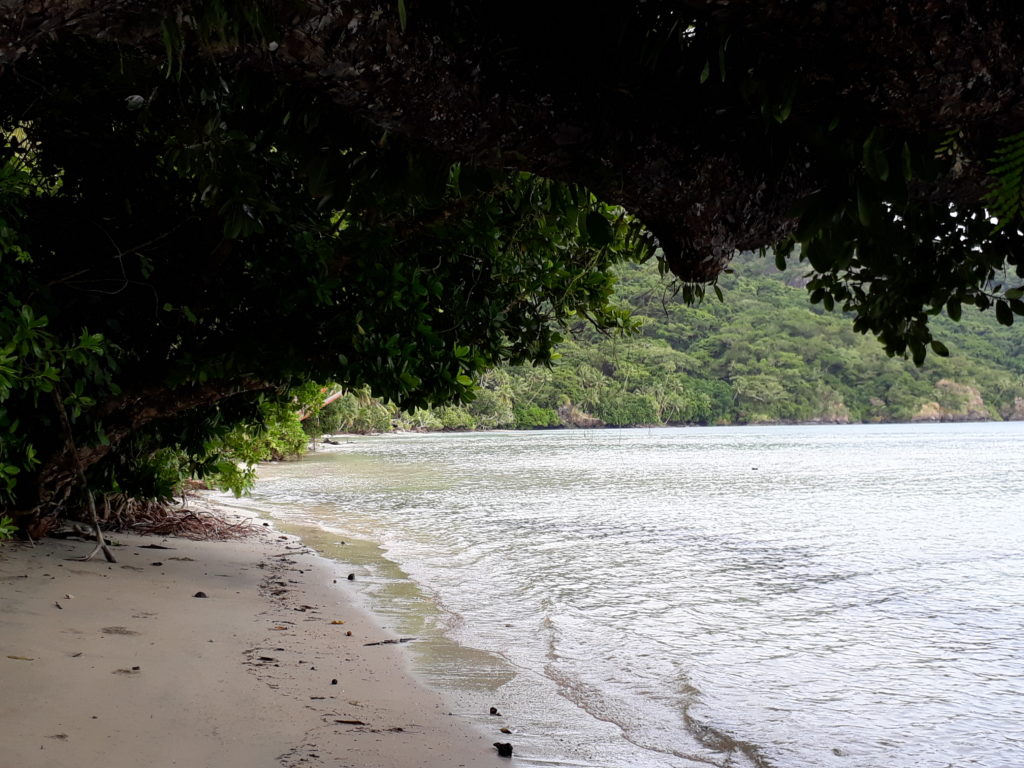
The guys living on the island of Rabi are displaced Banabans who had to leave their island. Not only did the island was stripped away of 90% of its surface between 1900 and 1970 for phosphate mining, but the population was relocated to Fiji by the British, after the Japanese occupation during World War II. Interestingly, they have decided to use the names of their original four villages for their new settlements in Fiji.
Nuku
The day after bringing our Kava to the beach, we got the dingy ready with the engine and I drove to Nuku. Driving a dingy is a bit different because the steering is the opposite of what the boat wheel is. It was quite challenging to concentrate on going straight all while keeping an eye out for coral and reefs. Nuku was about 6 miles away from our anchorage, which is a very long way in a dingy. It was very nice to see a town, even though Nuku is a very small one. The entire island of Rabi has a population of about 5000 Banabans!
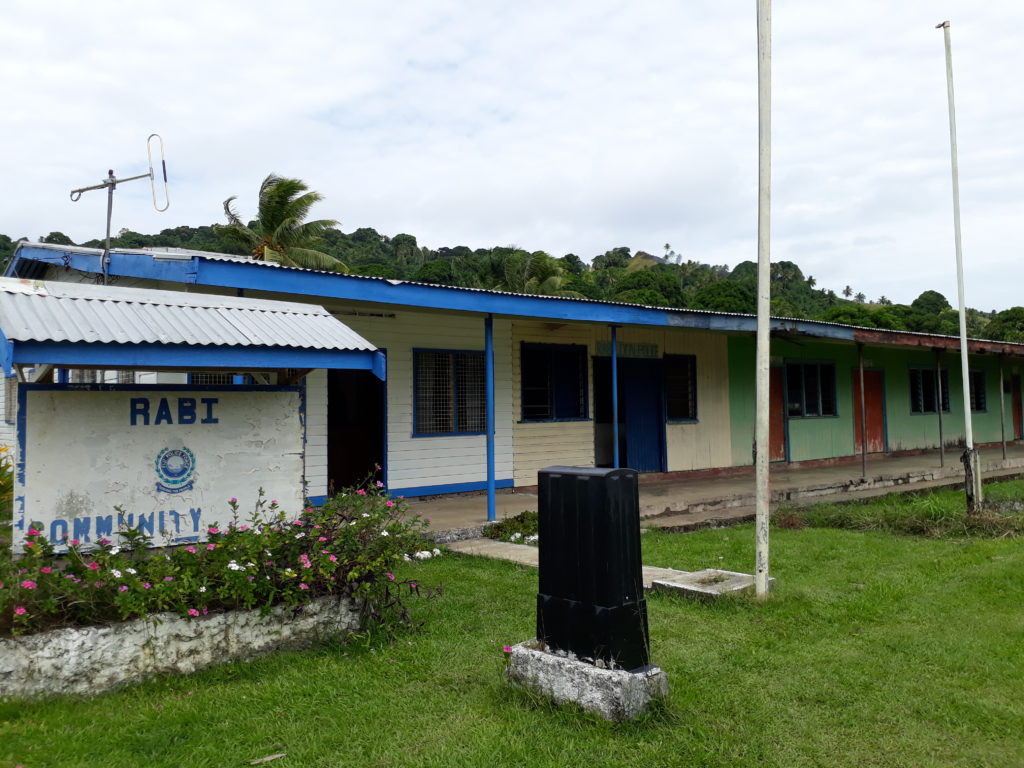
After getting the dingy secured on the small quay we walked to town. We stopped at the police station to check-in and register. It was a very quick process. They had a look at our boat papers and passports, one of them decided to make copies and we were all sorted. We walked towards the big Methodist church we had seen while sailing past.
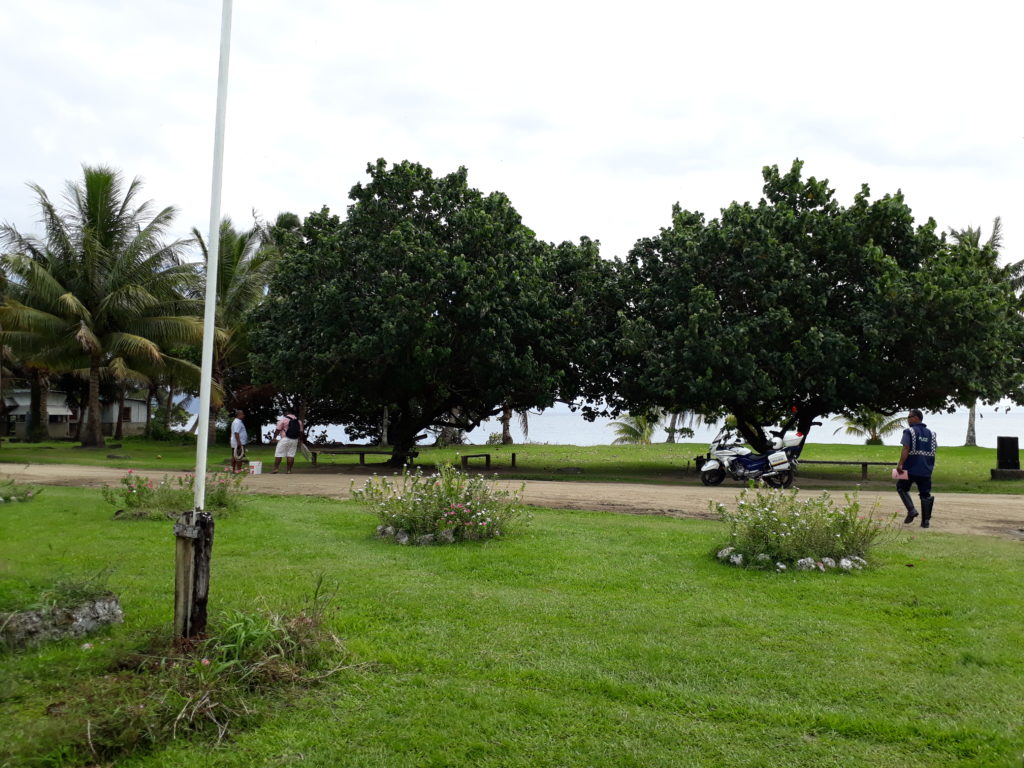
As we were going to walk into town, the police officer suggested we had a look at the coconut oil factory. It was a small house with many rooms and the lady gave us a little tour. They buy coconuts from the villagers, cut them and use a machine to collect the coconut meat. They have a hydraulic press to take the milk out. Once that’s done they leave the oil to bake in the sun. They have a dryer for the coconut flakes, sorting them into different grades. The brown ones for the pigs and the white ones for second-grade coconut oil, the one that’s not as clear as the virgin oil. It was a must to see the small business, and I was thankful the police officer called us as we were walking in the village as it would have been really easy to miss the small factory.
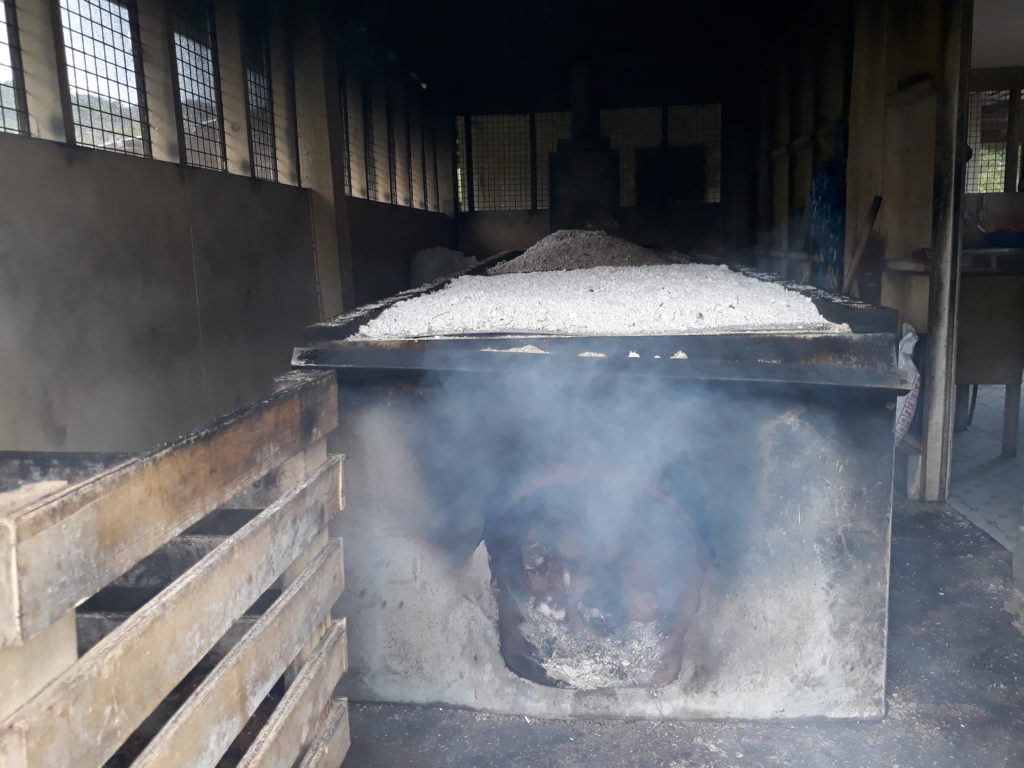
We walked across the village, saying hello or Mauri to everybody. They have many pool table bars which I was quite surprised to see. As well as churches for just about any faith; Adventist, Latter-day Saints, a mosque. A lot of churches for such a small place.
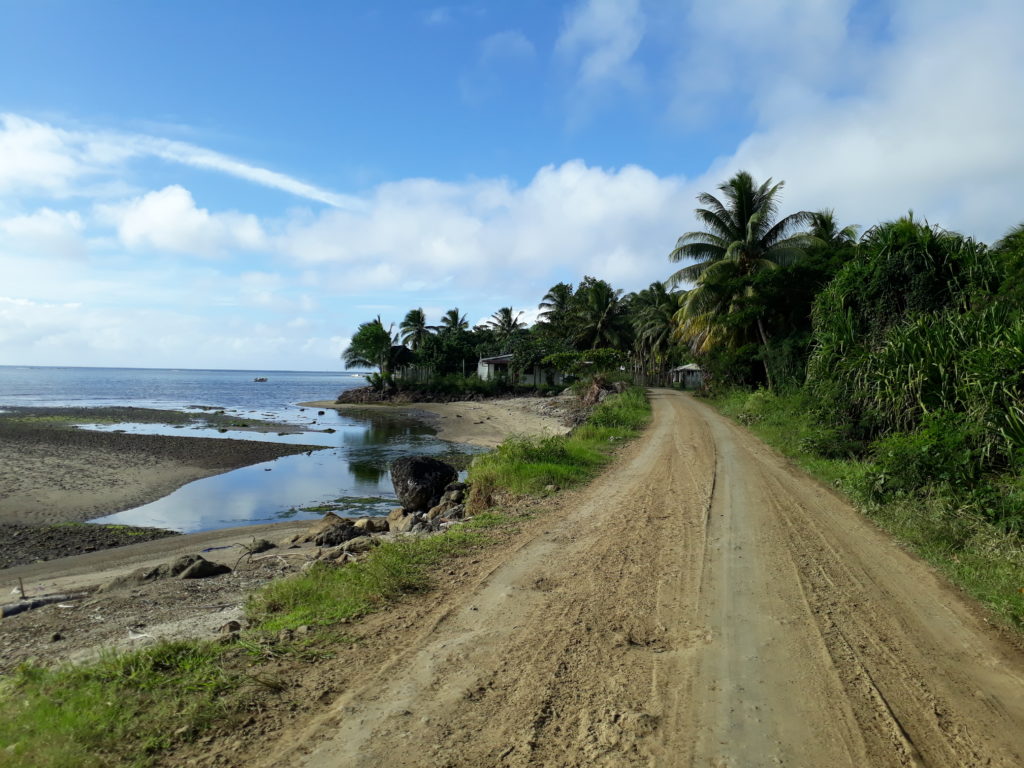
The walk to the church wasn’t that long but my legs felt really tired after over one month on sailboats. I hadn’t walked much since I had left Whangarei and it was like I had lost my muscle strength.
On our way back from the church we passed a school, and got to see the local transport: a small lorry, filled with smiling kids, no seats or seat belts visible!
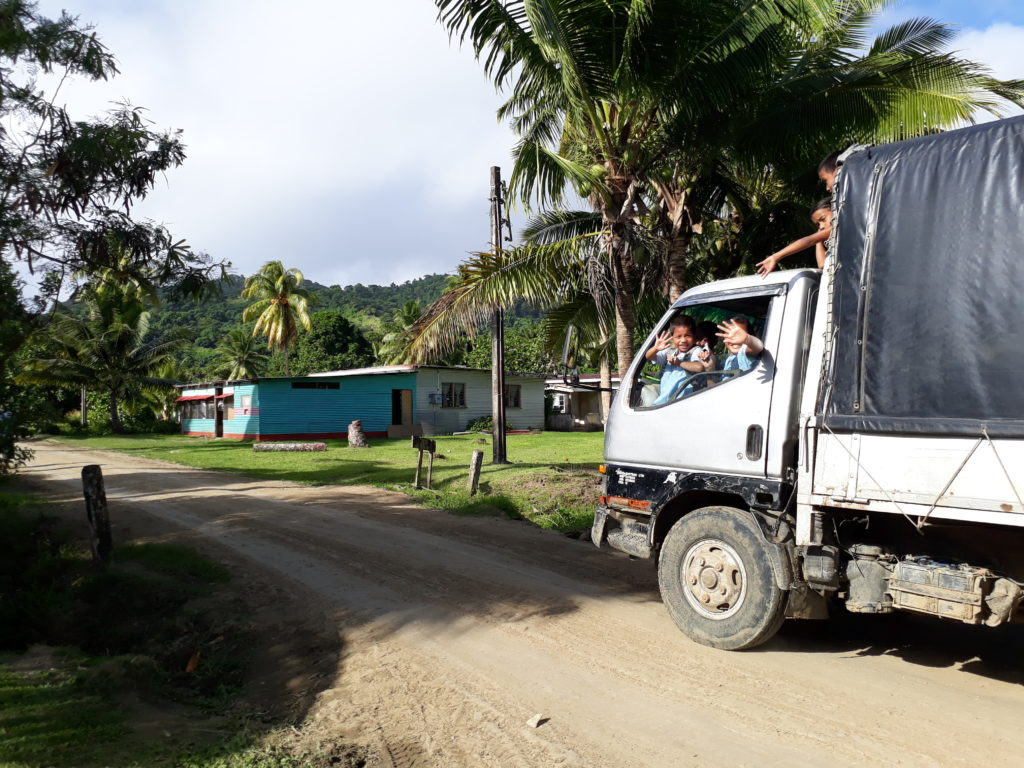
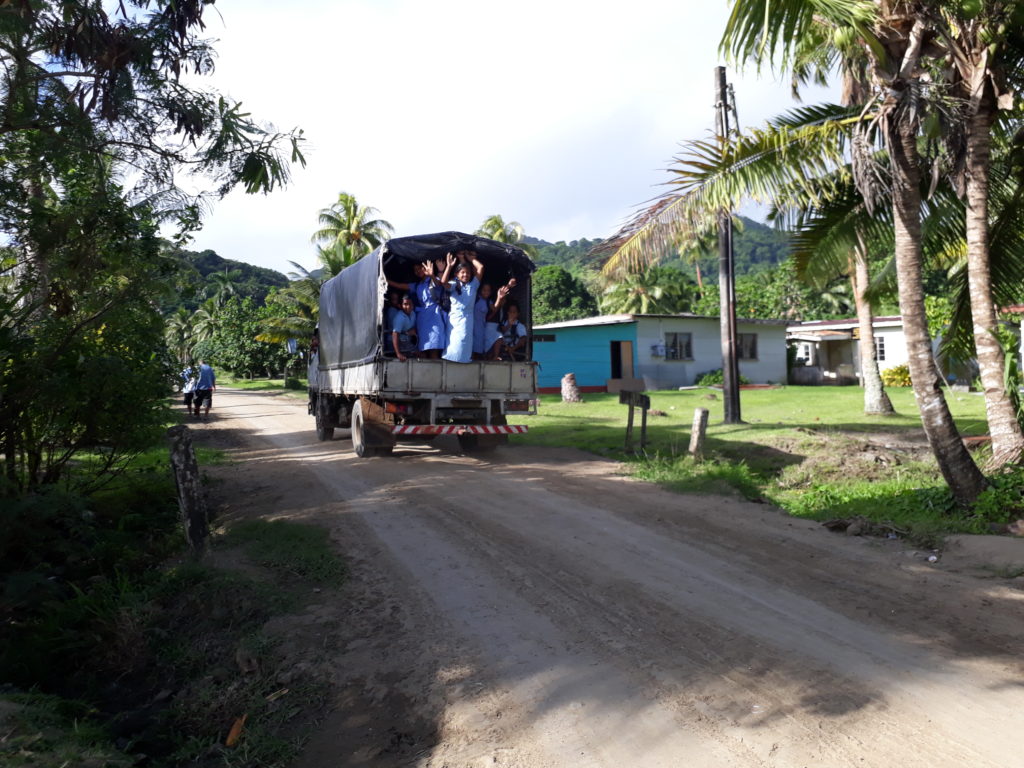
That night it rained a lot and I was woken up by water coming through my hatch. Just as I was falling back asleep, I heard a banging sound. A big black bird with its white curved beak, a lesser frigatebird, had crashed into the mast and broken its wing. She was all tangled into the mast support. I didn’t know the colour differences for both genders, but for some unknown reason decided it was a she. We untangled her and left her alone. She was still there in the morning. By then it was becoming clear we would have to move the boat and re-anchor somewhere further away from the reef. I looked at the bird and its wing was so heavy with water it was stuck to the deck. I lifted it and she pretty much jumped in the water. With a broken wing and drifting in the water, it’s very unlikely she would have survived very long.
Matei
In the morning, we had started drifting so we had to re-anchor in the pouring rain. We were looking at the forecast and it looked like it was going to clear up, before getting more rain in Albert Cove. We quickly packed everything and set off. The Ipad wasn’t following me so it was stressful to navigate out of the channel only with the numbers of the waypoint on the screen and Mark telling me if I was on track or not according to the GPS inside.
The same happened coming in Matei. We had to try to anchor twice. Then Mark went for a swim to check the surroundings. He was taking his time so I assumed it was all good but when he came back on board, after I had switched everything off, he wanted to move the boat. It wasn’t bad but I had just finished getting everything ready. We were both tired, probably stressed and not as patient anymore.
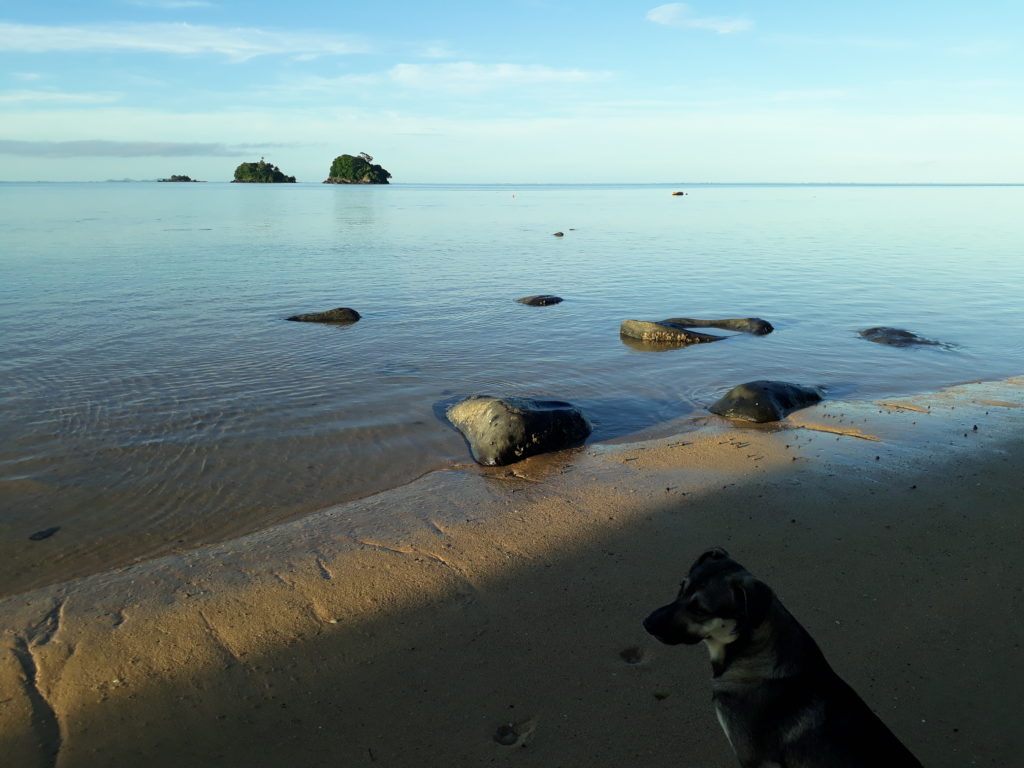
At that point, I was quite grumpy, so much that Mark offered to bring me to shore so I could have some alone time. When I got to shore, a dog welcomed me. I walked around for a bit, but since it was the end of the school day, there were kids and people everywhere. It wasn’t the alone time I had in mind.
I didn’t stay ashore for very long, actually just going to the supermarkets to buy crisps and chocolate and checking what products they had available.
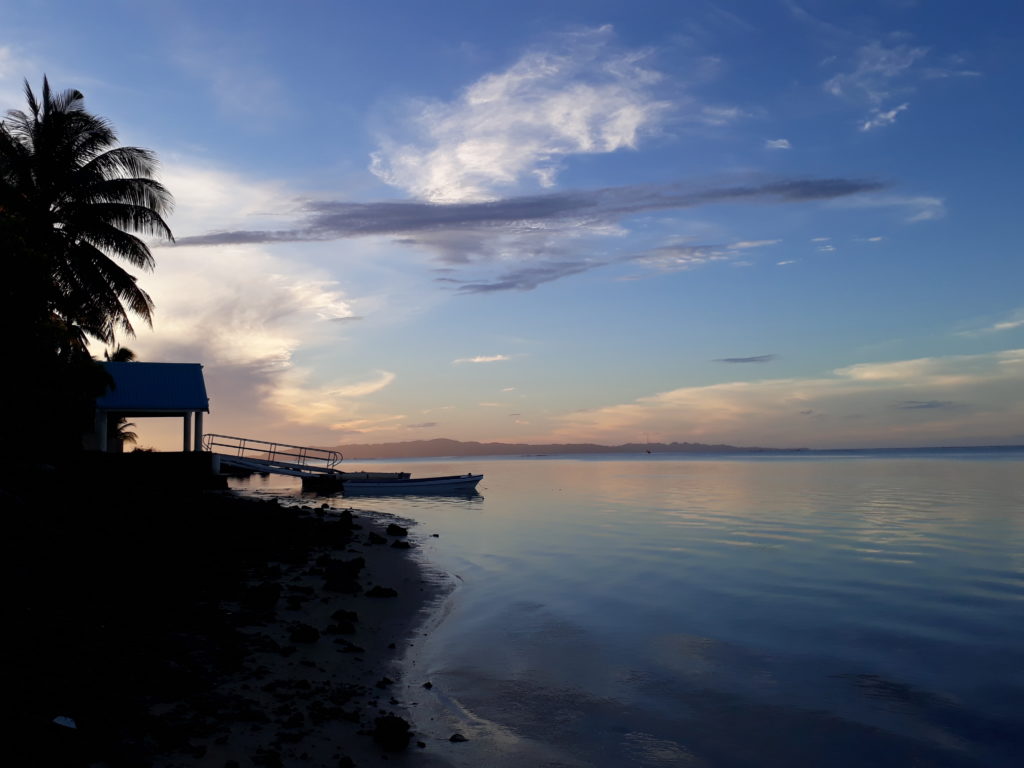
The next day, we went for a walk in town to have a look and stock up a bit on food. Matei has only one main road and the airport runway runs parallel to the street. It gets surprisingly busy in the morning or at least the day we were there with three planes coming in one after the other. They looked and sounded just like small skydiving planes. Seeing and hearing them made me realize maybe I wasn’t quite over skydiving as I originally thought.
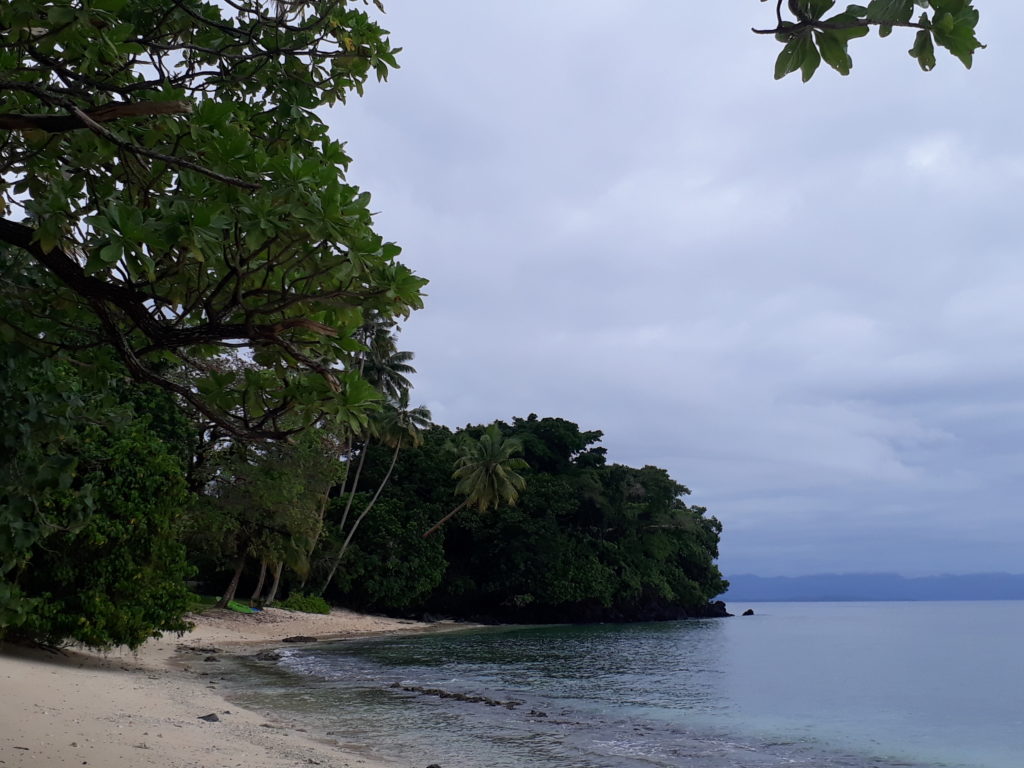
We walked on the main road, without a sidewalk, until an Italian restaurant we had seen on Google Maps and a sandy beach. I had a blister between my toes and as I walked over a line holding a dingy a wave lifted it and it got stuck between my toes, right in my open wound. I wasn’t happy. A rope burn on an open blister hurts like hell!
I needed to calm down, and also to be by myself so I kept walking to the other end of the beach. There was a cute little boy who was playing in the sand so I waved hello but he seemed very shy all of a sudden so I sat down on a rock and tried to calm down and enjoy the scenery.
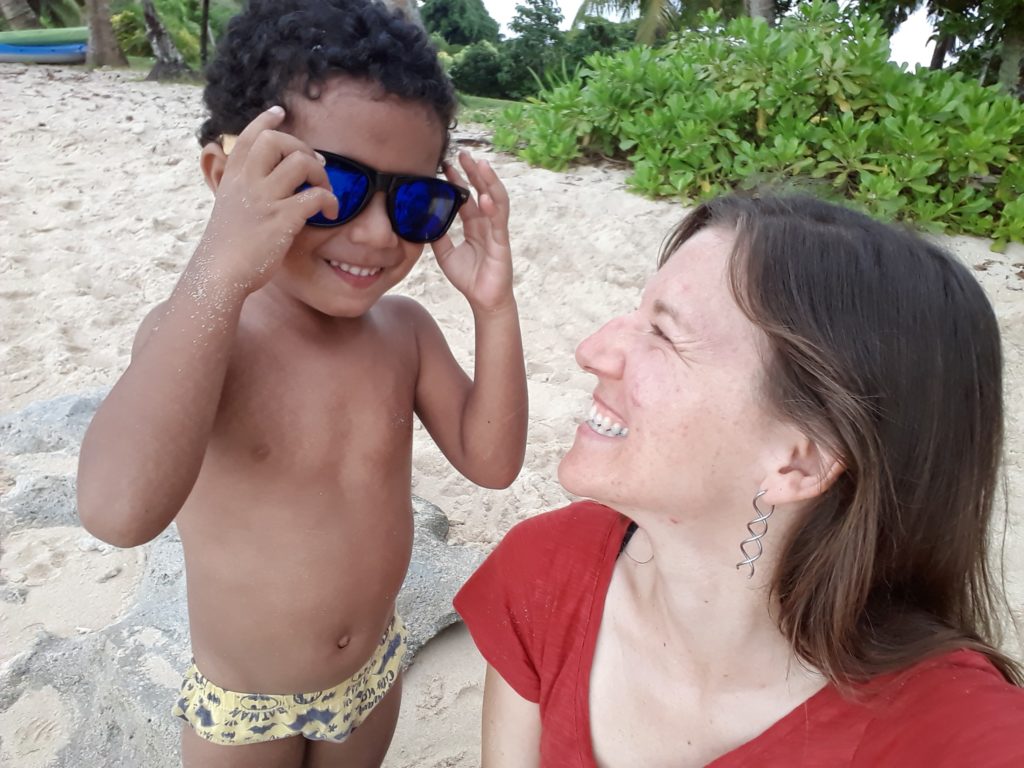
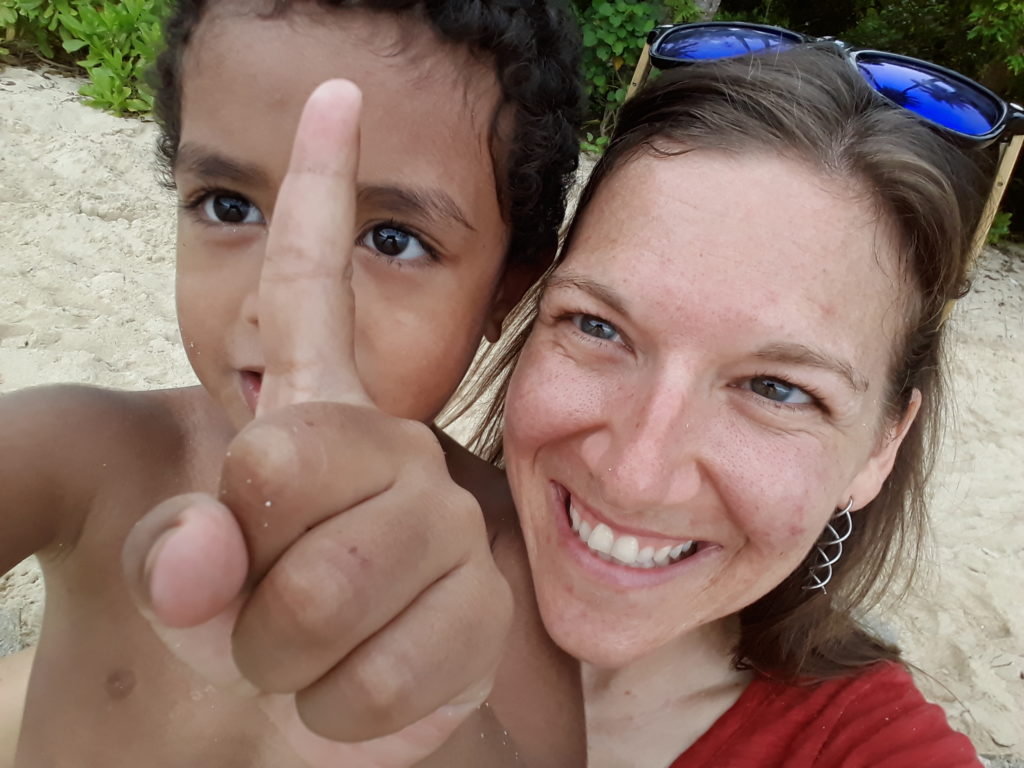
The little boy came to me, slowly getting closer. I had a quick look to make sure he had a parent somewhere. His dad smiled at me and gave his boy permission to come to play. Not that he was waiting on approval as by then he was playing with my sunglasses, putting them on and off, messing my hair up and taking photos. He was adorable and it obviously changed my mood instantly.
He was curious and happy and we played together until someone else arrived at the beach with a kid about his age. As much as I liked playing with him, by then I was running out of things to say since he didn’t speak English and I knew only two words of Fijian!
Lavena Coastal walk and Wainibau waterfalls
The next day we decided we could use another day of adventuring on land. As we were getting ready, the pod of dolphins (possibly the same one as in Albert Cove) or at least the same species came to feed around the boat. We then used the dingy and went ashore to wait for the local bus. It showed up shortly after 10 am. It took us just over an hour in an open-air bus, to get to Lavena Point. We passed several villages, many potholes and other vehicles on this one-lane dirt road. It was great!
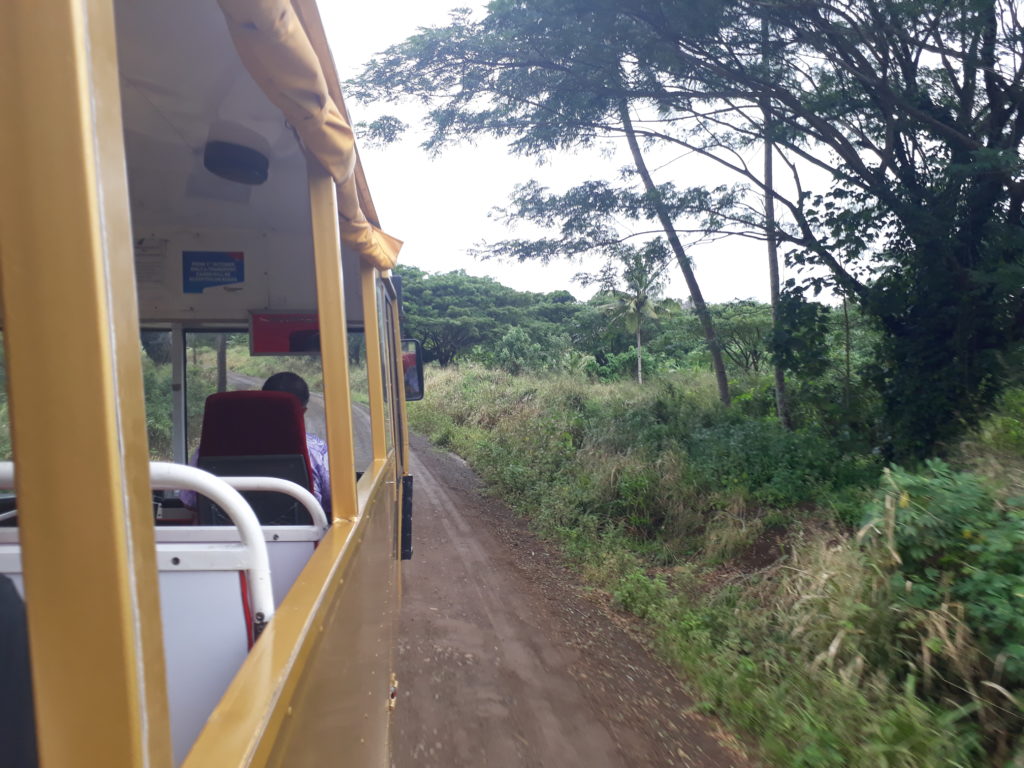
After a while on the bus, surrounded by a rather green and lush forest, we arrived in Lavena. There’s no sign per se, but that’s where the bus turns around making it obvious its the terminus! We checked-in at the information centre and paid our 30 Fijian dollars entry fee each. A bit steep but better than doing sevusevu in every village on the way!
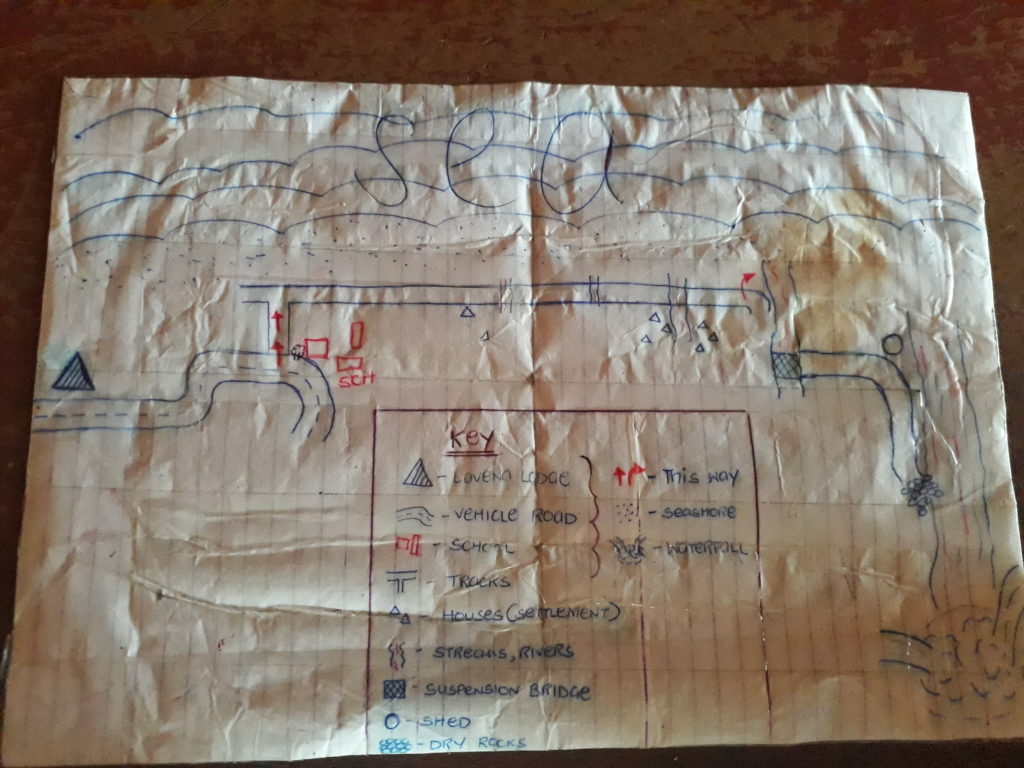
It rained and poured for most of the way. It took us about 1:15 minutes to reach the waterfalls after crossing streams and even one small river. We followed the directions given by the front desk lady, directions that made me think we may or may not be able to find the path and the waterfall!
I took a photo of the hand-drawn map she showed us, and as surprised as I was in Tonga when the guy drew a map for me, it was rather accurate. As instructed, after the orange building, we took a first left. Then when we reached the road turning right after the last settlement. We stayed on the left to be able to cross the stream before it gets too deep. It always makes me laugh when people tell me to do something after the last village. How am I supposed to know which one is the last?!
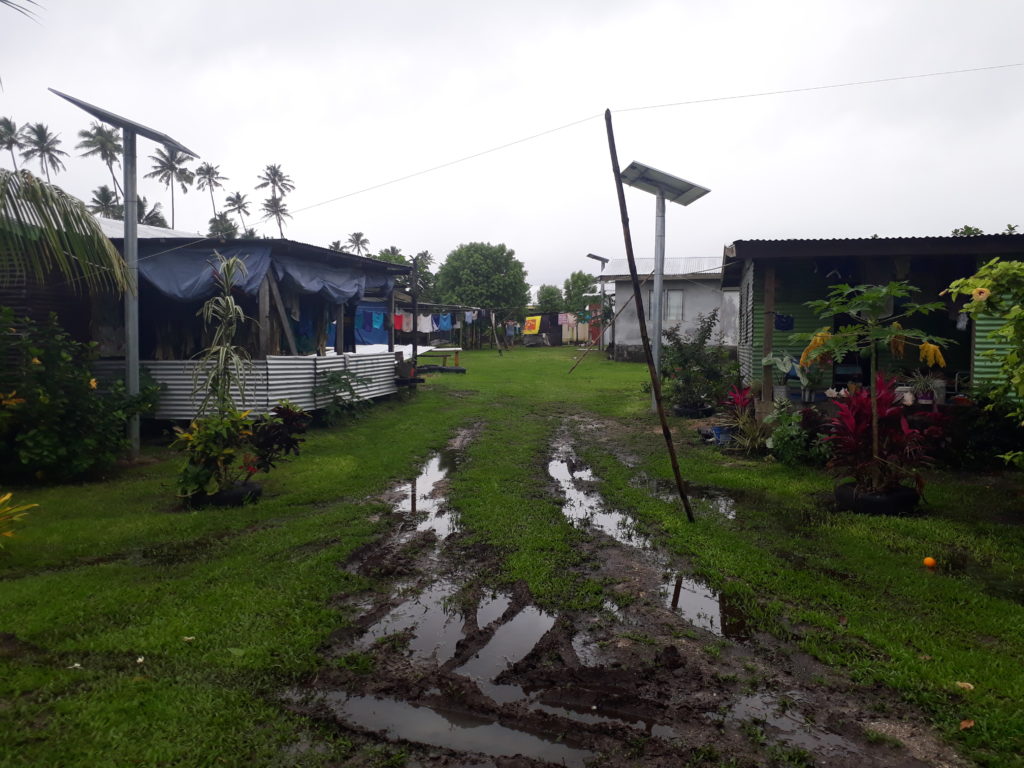
We kept going, and after our right turn past the shed, we followed the path up some stairs and found the dry rocks where we could leave our belongings.
We had reached the waterfall. It was beautiful. There was one other group there as we arrived. In order to reach the waterfall, we have to swim to it. I undressed to my bathing suit but kept my walking shoes as it felt more secure on the rocks. The water was quite cold and swimming with shoes on, in freshwater against the very strong current created by the waterfalls wasn’t easy. The rocks are also quite slippery so you need to be a fairly strong swimmer to go there. However, when you reach the main waterfall, there’s a little surprise in the form of a second waterfall hidden from view. The basin which was formed by the waterfalls seems pretty deep and is surrounded by lush vegetation. It’s a special place.
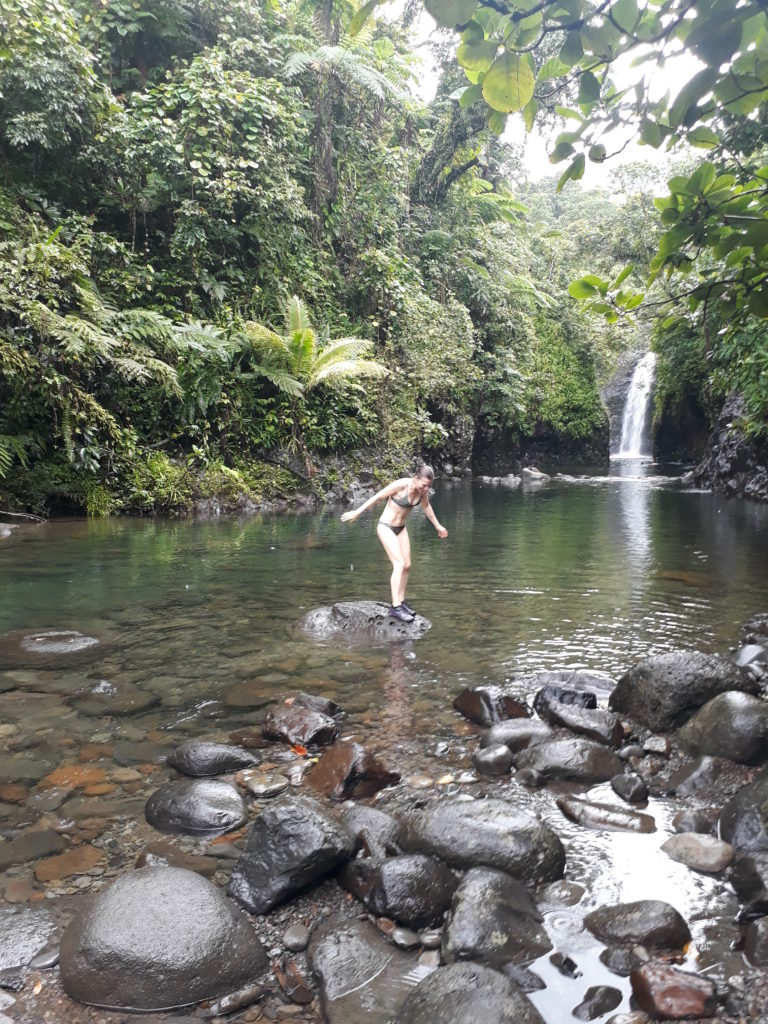
After a few minutes in the water, playing around and simply enjoying the place, we swam back to the dry rocks. It was a lot easier to swim with the current than against it! We got dressed and started our walk back to the village.
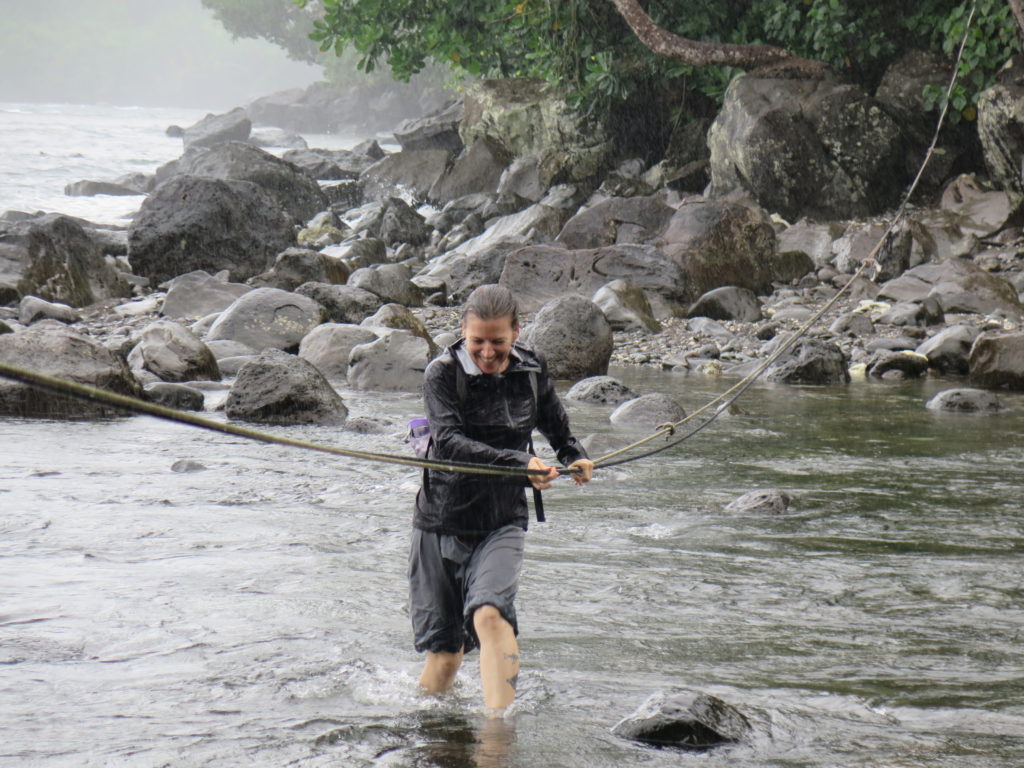
It rained for most of the way back, a typical tropical rain, which means we were drenched when we got to the bus stop!
On our bus ride back, we kept picking up people in every village. A lot of overly excited unaccompanied kids with small backpacks. Once a year, there’s a two-day rugby and handball tournament for all the elementary school kids of Taveuni. The winning teams will then go on to play on the mainland. It’s a very important event for the local population and we were rather lucky to get to witness some of the excitement and preparation.
The islands of Fiji are so varied from one to the other, I felt very lucky to get to see more than the resorts. Having the chance to explore islands on Macushla allowed me a much closer look and fascinating encounters. So many indeed that I had to split this blog post in two. You can find the second part of my exploration here!
1 thought on “Exploring Fiji Islands – Part 1”